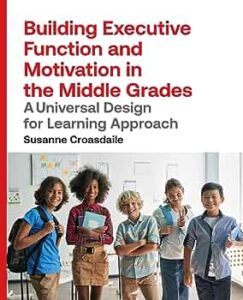Tools to Help Students Lessen Memory Overload
We recommend you set aside some time to explore this information-rich introduction to developing executive function, effort and persistence, and self-regulation in middle grades students. You’ll need to watch some videos, learn some new terms, and become familiar with details of the Universal Design for Learning. The payoff? You’ll be able to help young adolescents develop strategies to better cope with the memory overload that’s common at their developmental stage.
By Rachel Tew and Susanne Croasdaile

Rachel
Time is precious. As educators, we understand the importance of making every second count as we support the diverse needs of our students, especially the reluctant learners. With the executive function challenges our students face in middle schools, strategy instruction is the key to success.

Susanne
As educators, we see the world through a framework or “lens.” Like wearing a pair of sunglasses, everything we see takes on that color. Lenses guide our decision-making.
In our own teaching, we use Universal Design for Learning (UDL), based in neuroscience (brain research), as our lens for seeing the world and reducing barriers to student success. The UDL framework has helped us make our students independent learners, and a critical component has been teaching learner-owned strategies that address executive function weaknesses and increase learner expertise.
The UDL lens and the “Cautious Corner”
When we look at the lower right section of the UDL Guidelines 2.0, we see Guidelines 6, 8, and 9. We call this the “Cautious Corner.” Executive function, effort and persistence, and self-regulation are all areas we should be “cautious” about when requiring them of middle schoolers.
Why are these areas of brain function barriers for pre-teens and teens? Because the working memories of young adolescents get overloaded and they have not yet developed fluent coping strategies. Efficient strategy use is the key to our success (and failure) as adults. Let’s take a look at how this centers on working memory.
| Cautious Corner video: https://www.youtube.com/watch?v=EoK3sm4E_wk |
Learner-owned strategies reduce cognitive load by reducing the weight on working memory
Your working memory (and that of your students) can be represented by a sticky note. Sticky notes come in different sizes, from tape flags to chart paper. Whatever fits on that sticky note is your working memory, or what you can remember in the short term to complete a task (see this one-minute video by researchers Tracy and Ross Alloway below).
The size of your working memory is set by age 8, and from then on, you have to develop coping skills for when your working memory is “full.” This is a huge challenge for our middle grades students, who are expected to take in new information and follow new directions all day long!
How do we solve this problem? Most adults ease the cognitive load on their working memory through establishing consistent routines: this is my waking-up routine, my just-arrived-at-work routine, my making-dinner-and-clean-up routine…all things you’re expected to do each day.
Some people joke about being on “auto-pilot.” When our routines are disrupted, we feel stress or frustration because our brains are protesting, “But this is how I do it!” Suddenly our working memory is used up on new steps and directions that prevent the skilled, fluent performance that occurs when we’re on “auto-pilot” (using long-term menory).
Students need the same consistent routines we do – and not just for behaviors. They need strategies for starting to read in a noisy environment, annotating a complex nonfiction text, solving a word problem…all things middle schoolers are expected to do each day. But most students have not yet turned all the routines they need into habits. So how do educators make this happen?
The routine-into-habit solution lies in using explicit instruction with encouraging and constructive feedback. Unlike our just-arrived-at-work routine, which we likely developed for ourselves based on trial-and-error, for a student to (for example) annotate nonfiction text, they need someone to:
- Model the strategy
- Set aside time for the student to practice it
- Give reinforcing feedback until it becomes a habit (at least 20 times, but closer to 35 for struggling learners), then
- Cue the student to use the strategy
If all these things are in place, the student lodges that routine in their long-term memory. They will annotate text on auto-pilot because their brain tells them “This is how we do it.”
Sometimes students learn these strategies from an older sibling or parent, and teachers may mistakenly assume it’s what all students should be able to do. But the research tells us otherwise.
In general, it’s our role as classroom teachers to make sure students develop strategies that ease the loads on their working memory “sticky notes,” whatever their size. If we do that, students will be scaffolded to start learning the more difficult executive function, persistence, and self-regulation skills in the UDL Cautious Corner.
Why should we use “strategy instruction” to help a student be successful?
Let’s take a look at Aiden. He’s a typical 7th grader – far more concerned with what is happening with his friends outside of class than with the academics in class. But when you talk with Aiden, he always tells you he’ll try harder and wants to do well.
If you ask Aiden about the strategies he uses to get his work done in class, they seem as disheveled and unorganized as the papers randomly stuffed in his backpack. He asks nearby students for help – and is redirected by teachers for talking. He gets lost in multi-step directions and asks to go to the bathroom – and is gone for longer than he should be. Although Aiden has the will to do well in school when you talk with him, he doesn’t seem to have the skill to get anything done.
We all know students like Aiden: we invest time in one-to-one conferences with them and then get frustrated when they aren’t more successful in learning! But here’s a hidden reality: he doesn’t need a pep talk; he is easily overwhelmed with seeing a different teacher for each subject, and he has not become fluent in the learning routines each adult wants to see.
Why? Well, in most cases, his teachers are giving him directions but not teaching him learning strategies. They are inadvertently loading up his working memory but not building out his learner toolbox. Aiden’s teachers are expecting him to have the executive function, persistence, and self-regulation skills in the UDL Cautious Corner without building the fluent strategies that free up cognitive space for him to do what has been asked of him.
The UDL lens uses strategy instruction to address executive function weaknesses.
To build a learner toolbox, we teach strategies. Learning strategies are routines that are taught through explicit instruction. When students like Aiden are taught a learning strategy, they don’t just arrive for class and follow directions. Instead, they are cued to reach into their toolbox and use a specific learning strategy.
Here’s an example: Aiden comes into class and his teacher greets him and says, “Get your binder out and use THIEVES to annotate the text from our last class.” This time, Aiden’s working memory only has two things in it:
- Go get your binder.
- Use your THIEVES strategy on the text from last time.
How does this strategy scaffold Aiden’s success? Well, first of all, he won’t need to ask everyone what they’re doing since it’s a routine he knows. Second, it’s not a multi-step direction: THIEVES is a chunked routine that makes seven steps into one fluent practice. Instead of giving seven separate directions, they have cued a single strategy. This frees up the cognitive load on his working memory much like our just-arrived-at-work routine lets us focus on answering our email and setting up our classrooms for the day!
| Here’s an example of teaching THIEVES to chunk a multi-step routine: https://www.youtube.com/watch?v=GVMb2zBDKqc |
Why is this so important? The key is that learner-owned (especially mnemonic) strategies go into long-term memory. These are the scaffolds we learn over time to cope when our working memory sticky note is full. This helps students when they are distracted, stressed, tired, or overwhelmed – just like us!
How do we start addressing executive function weaknesses with strategy instruction?
Looking at your instructional calendar is the first step to using learner-owned strategies to reduce cognitive load by reducing the weight on working memory.
What tasks do you want students to do independently? Put them on the calendar and then take a look at how long it will be before you can expect students to do those tasks. That’s the amount of time you have to teach the “chunked” strategies students will need to independently engage in those tasks.
Thinking deeply about all the parts of a complex task is called “task analysis.” Task analysis helps us see where those student working memory sticky notes are likely to get overloaded. It’s the strategy instruction part of systematically designing instruction toward a specific learning goal.
By systematically looking at each task on a calendar, you can see how your lessons and activities build on each other. This lets you scaffold students like Aiden by teaching toolkit strategies and then cueing students when to use those strategies.
If you know executive function, persistence, and self-regulation are going to be issues when you look at the tasks on your calendar, then you’re dealing with the UDL Cautious Corner. You’ll need to explicitly teach strategies – or their working memories might overload.
Let’s be realistic: Some students pick up learning strategies quickly, and others are slower to achieve fluency. Absences or sleeping in class – challenges we all deal with – slow students down on the road to fluency. Use a checklist on a clipboard to track which students missed the strategy instruction (even if they were present that day) or need another round of it. After 20 or so days of actually practicing a learning strategy, most students will perform it on auto-pilot – and their working memories will be freed up for higher-order thinking skills and complex tasks!
Conclusion
If we want to reduce executive function barriers in the UDL Cautious Corner, we need to teach learner-owned strategies. These learning strategies reduce the weight on students’ working memory and let us assign higher-order tasks without unnecessary cognitive load.
Teaching these strategies also builds student confidence in their toolbox skills! Using a calendar is the best way to get started; you don’t have to wait until next year. After a few days of teaching your first learning strategy, you’ll start seeing the results of scaffolding students’ executive function with strategy instruction.
Check out Susanne’s article Use “First 20 Days” Planning to Prep Kids for Success for more on how to plan strategy instruction in your classroom or grade level and use a calendar.
Join our UDL and Executive Function group!
Plan strategy instruction for this year or to start strong next year! The National Writing Project’s Write Now Teacher Studio, an online community for teachers by teachers, is hosting a FREE group about starting the year strong and building adolescent student toolkits. Join us here by creating an account.
Rachel Tew has been a classroom teacher, special education case manager, behavioral coach, administrator, and professional developer in Florida, Indiana, and Virginia. She is currently the Coordinator of Assessment and Remediation at Matoaca Middle School in Chesterfield, VA. Her passion is supporting teachers and students behaviorally and academically through establishing routines and systems to engineer success.
 Susanne Croasdaile is the author of Building Executive Function and Motivation in the Middle Grades: A Universal Design for Learning Approach, which focuses on Matoaca Middle School in central Virginia. She has been a classroom teacher, instructional coach, professional developer, program specialist, systems change consultant, and associate director of curriculum and instruction for public schools in Virginia and Louisiana.
Susanne Croasdaile is the author of Building Executive Function and Motivation in the Middle Grades: A Universal Design for Learning Approach, which focuses on Matoaca Middle School in central Virginia. She has been a classroom teacher, instructional coach, professional developer, program specialist, systems change consultant, and associate director of curriculum and instruction for public schools in Virginia and Louisiana.
Feature image by Venita Oberholster from Pixabay































